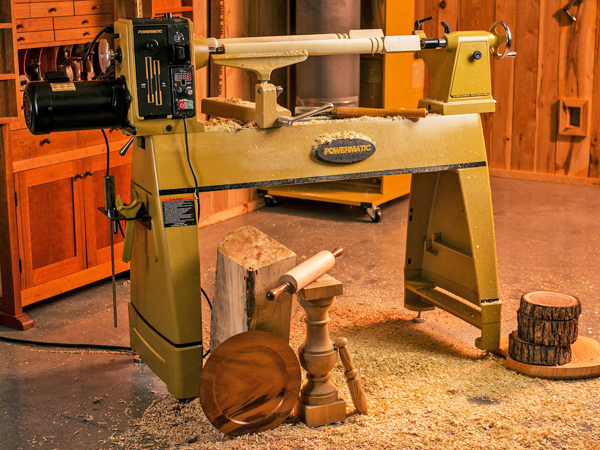Turning Wood at Home – Wood Lathes

As one of the most ancient and coveted woodwork specialties, woodturning continues to bring awe to the eyes of onlookers and brings more and more woodworkers flocking to watch wood shaving flying away at rapid speeds.
Woodturning is the process in which a woodworker uses a tool, known as a wood lathe, to suspend the piece of wood between two points and rotate this wood along a horizontal plane. When the wood is turning along this plane, the woodworker uses a special set of chisels to determine the final shape of the wood.
Before the introduction of a motor, this machine was manually powered by foot pedal attached to a long piece of twine driving a fly-wheel and operated by a hardworking woodworker much like what can be seen below:

These days, wood lathes are motorized with direct and belt-driven motors, with the former often being more expensive. Beginner woodworkers often have to deal with the issue of space; as such the most common beginner wood lathes are made small enough to be mounted on a benchtop – permanently or temporarily. These wood lathes are usually around a meter in length. The length of a wood lathe usually refers to the distance between the headstock and tailstock. The image below will give an idea of how these look.

Most modern wood lathes, even the most entry-level and affordable, have a variable speed function that allows the user to manipulate the RPM of the woodturning. For the more entry-level and older /cheaper models, this speed can be changed by opening the motor cover and manually changing the position of the belt to various points specified by the manufacturer.
For those looking for a more convenient and efficient solution, there are wood lathes like the Laguna Revo 18|36 that has an electronic variable speed function which makes the changing of the speed as simple as pushing a button or two.
As one grows in their woodturning, there will be a need to do larger work. This will require a longer bed and often a large swing. The swing of a lathe refers to the maximum diameter of material which can be turned on the wood lathe. This evolution will then force the woodworker to venture in the world of full standing wood lathes which are mounted on legs which take this swing into account.
These lathes also have stronger motors, allowing for larger pieces to be turned without adding too much stress on the machine.
Currently, a very popular range of lathes is sold by the Toolmate and Jet brand. Both of which are of great quality. The Jet being the one more inclined for professional usage and the Toolmate ideal for small/home workshops.
Certain upgrades can be added onto a lathe to aid in making woodturning easier and more geared to your line of work. In our next article, Turning Wood: Holding Wood, we will be discussing the various woodturning chucks that are available as well as the faceplate used to hold them.


Comments
Add comment